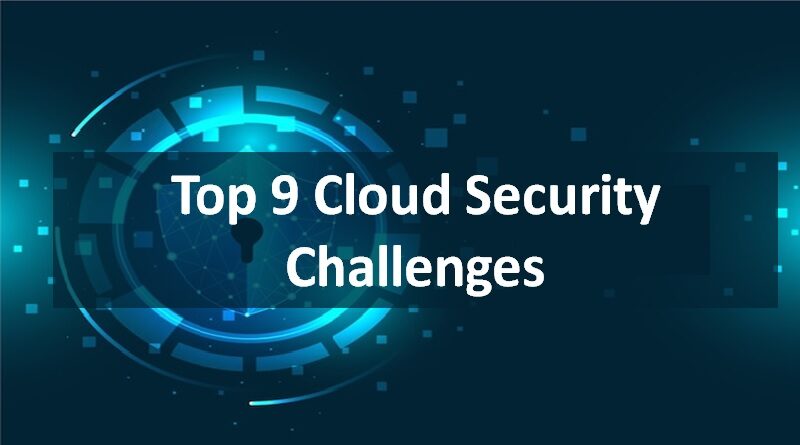Top 9 Cloud Security Challenges
You need data as a business to forecast market and target user trends, find pertinent opportunities, and sell your brand to the appropriate demographic. You may already have data centres with knowledgeable data analysts on staff.
And it’s possible that your analysts are gathering and compiling big blocks of data utilising data analytics technologies in order to transform it into figures that make sense to you. You may stay one step ahead of your competition by using these statistics to better understand your customer base. We can all therefore agree that data is crucial! Sensitive data must therefore be protected from theft and nefarious use.
We’ll examine cloud security in more detail in this article, as well as the most prevalent problems with cloud security that businesses encounter today. You won’t be left with only half the information, don’t worry!
In order to address the security issues with cloud computing, we’ll also assist you in identifying the security methods and solutions you can use. By the time you’ve read this blog’s final paragraph, you’ll understand not only the security dangers associated with cloud computing but also how to avoid cloud attacks.
Top Cloud Security Challenges and How to Combat Them
Let’s now quickly review the main cloud computing security issues and their solutions.
1. Data security breach
Data breaches continue to rank among the biggest security issues that cloud computing service providers and their end users must deal with.
Without a doubt, data breaches pose a severe risk to any organization’s sensitive data and have the potential to seriously harm both the company’s finances and reputation. As a result of data breaches, which may result in the loss of the company’s customers’ personal information, it may also result in regulatory measures.
A corporation should take all reasonable precautions to prevent data breaches because they could be fatal and reduce the value of the company as a whole.
Quick fix:
You can adopt and apply a number of cloud security solutions to guarantee that the sensitive data held by your business is safe and secure against all types of data breaches, including:
- To put backup plans in place, you can determine the value of your data and estimate the effects of a potential data breach.
- To keep your user data secure, you must encrypt all of your data.
- You must create a foolproof incident response plan that has been tested against fictitious security occurrences.
- Roles and permissions must be established to control users’ access to data.
- Implementing procedures and regulations that guarantee the secure removal and deletion of outdated data is necessary.
2. Poor planning prior to implementing cloud security
To paraphrase a well-known proverb, if you don’t plan your adoption of cloud security, you’re planning to fail when it comes to carrying it out.
Many businesses rush into the adoption process without careful planning because they are so thrilled about the idea of embracing cloud security. It’s crucial to develop plans for implementing the shift to cloud security.
What about raising your customers’ awareness? You must inform all of your stakeholders on the benefits and risks of cloud security before implementing it.
Quick fix:
In order to prevent becoming victims of cyberattacks that may cost them money, their reputation, or even legal action, you need to make sure that your customers are aware of the dangers to which they may be subjected when their data is stored in the cloud.
- When preparing for your move to cloud security, bear the following in mind:
- Plan your cloud security architecture so that it satisfies both your immediate and long-term objectives.
- Create and implement a framework for architecture that meets the needs of all stakeholders.
- Make sure you’ve put monitoring procedures in place for all data movement.
- Limit traffic coming from shady links and sources.
CHALLENGE: Inappropriate Asset Setup
3. Inappropriate Asset Setup
(Banner content: Cloud resources should always be correctly set up.)
The wrong configuration of cloud assets, which are typically utilised for storage reasons, is yet another significant problem that might arise when you embrace cloud security. When you don’t configure your cloud assets properly, you leave them open to outside threats.
Furthermore, more than only the storage assets need to be configured properly. Your cloud environment is also left open to attacks if roles and permissions are not specified to control permitted access to the cloud assets you have configured.
Quick fix:
Avoid cloud misconfigurations brought on by inadequate change management. To allow speedy changes in on-demand and real-time cloud settings, automate your change control processes. The following are additional considerations:
- Screen and keep an eye on all of your information that is available online.
- By identifying the importance of your data and the negative consequences of data loss, create a fail-safe and well-tested incident response plan.
- Ensure that all parties involved abide by the rules governing data testing, release, and change management.
- Make conducting simulated contingency response drills and risk analyses on a regular basis a best practise.
- Inform all interested parties, including end users and independent contractors.
4. Insecure Interfaces and APIs
High-risk areas include the user interfaces and APIs that enable customer interaction with the cloud services you provide. For the purpose of preventing data breaches and harmful attacks, it is your responsibility to make sure that all such user interfaces are safe.
Quick fix:
Among the many strategies for reducing the threats to cloud security brought on by insecure APIs and other user interfaces are the following:
- putting criteria for excellent API hygiene into practise.
- preventing the reuse of API keys will increase security in the cloud environment.
- utilising open frameworks with common APIs that are continuously monitored.
- implementing the industry’s best practises for creating and designing APIs.
5. Poor Cloud Visibility
Having a thorough overview of all your cloud-related activity is referred to as cloud visibility. You will find it simple to identify security issues because all of the information relevant to your cloud security is available from a single touchpoint. You will also be able to adjust and monitor the performance of your cloud deployments.
Enterprise administrators confront a number of difficulties when they have poor cloud visibility. Shadow IT, which occurs when employees utilise apps that are not authorised by the IT administrator yet go undetected due to poor cloud visibility, is one such issue. It goes without saying that such apps leave your entire cloud environment open to dangers from the outside world and harmful hacker attacks.
In other words, poor governance and ignorance caused by inadequate cloud visibility eventually lead to a breach of data security.
Quick fix:
You can take a number of steps to make sure that your staff do not unintentionally expose your sensitive data to assaults and that your cloud visibility is clear:
Employees might be instructed on the value of utilising only IT-approved and controlled applications.
You can design and deploy a cloud visibility initiative that addresses the security and all other facets of your cloud services.
You can need best practises and acceptable usage of cloud assets training for all of your employees and other relevant stakeholders.
You can set up a hierarchical approval system to limit access to sensitive information to just those who have been given permission.
You may keep an eye on your employees’ and the cloud’s actions, as well as periodically run risk assessment exercises.
You can make sure that all of your cloud-related actions are accurately documented and that thorough logs are kept that track all staff activity.
6. Issues with Identity and Access Management
Issues with IAM (Identity and Access Management) (identity and access management) can be linked to yet another common cloud security issue that enterprises encounter. Let’s say you don’t employ automated cryptographic keys or password rotation techniques, or you don’t take the necessary precautions to protect your user credentials. If so, your cloud activities may be vulnerable to security risks.
You need to be on the lookout for provisioning and de-provisioning issues while managing the enormous number of cloud accounts and doing inventory, tracking, monitoring, and management. You should also watch out for issues with creating roles and privileges, zombie accounts, having too many admin accounts, users evading IAM rules, and all of these things.
Quick fix:
The numerous cloud accounts connected to your business and its data require monitoring and control, but you may reduce the risks associated with IAM by taking a few small yet effective actions, like:
Make sure you enforce a 2F (two-factor) verification method for your user accounts as well as appropriate credential protection measures.
Make use of automatic keys and strong passwords that are updated frequently.
Put strict IAM rules and checks in place for all of your cloud users.
When an employee is let go of their job, conduct a frequent analysis of your database and eliminate any unused or undesirable credentials, accounts, or access privileges.
Ascertain that each major account holder and stakeholder is aware of their roles, obligations, and privileges.
7. Insider Risks and Related Threats
We’ve mainly been concentrating on removing hazards from outside so far. But when it comes to cloud security, there are internal hazards that you need to address, whether they are deliberate or not.
If your current or former employees are careless with their responsibilities or lack the requisite knowledge regarding cloud security issues, they could be viewed as a possible weak link. The same goes for any stakeholder or ex-stakeholder, for that matter.
Employee negligence exposes your cloud environment to a variety of dangers that may result in data breaches, data loss incidents, downtimes, and errors, all of which may reduce customer loyalty and revenue.
Quick fix:
Now, you are not solely responsible for addressing this kind of cloud security problem. Instead, it is a shared responsibility model that all of your stakeholders, including your staff and end users, must manage.
- Here are some techniques for reducing insider threats and human slipups that might result in data leaks, theft, and incorrect cloud configurations:
- Training seminars on cloud security can help your stakeholders become more informed.
- You can use tactics to find, keep an eye on, and repair misconfigured servers.
- To limit access to crucial systems, you can assign lead admins responsibilities and permissions.
- You can establish stringent multi-tenancy rules.
8. Potential Cloud Account Hijacking
Hijacking of cloud accounts is a serious worry for businesses that have switched to the cloud. It may result in the unintentional or intentional disclosure of privileged cloud accounts that are essential for the management, operation, or upkeep of a cloud environment.
Malware assaults like phishing and credential stuffing can result in such data breaches. It can also happen as a result of incorrectly protected credentials, bug-filled code, and other issues.
It’s important to remember that account hijacking can have far-reaching effects and doesn’t just involve changing your password and locking you out of your cloud account.
Quick fix:
Hijacking a cloud account poses a severe risk to your business and puts your sensitive data at the whim of others who may have nefarious intentions.
- putting in place extremely complex identity and access management controls.
- ensuring that you use tactics like strong passwords that are frequently rotated.
- Making a business continuity strategy will assist you in preventing business interruptions in the event of an emergency.
- ensuring that essential accounts receive additional protection and that production and non-production environments are kept apart.
9. Collapse of the Waterline and Applistructure
Let’s now examine how a collapse of the metastructure, also known as the waterline, would impact cloud security. In essence, the waterline or metastructure marks the boundary between cloud service providers and their clients. You can only picture the havoc that would result if this crashes!
Data loss, business disruption, as well as legal and financial issues for your company, can result from a waterline collapse.
Quick fix:
There are many approaches to make sure your cloud security measures are effective enough to prevent metastructure collapses, some of which include:
- Include regulations that guarantee you always have cloud visibility over all user activity.
- To assess the strengths and vulnerabilities of your cloud infrastructure, perform frequent penetration testing.
- If an unavoidable waterline collapse results in any operational problems, have a tried-and-true backup plan in place.
- Keep lines of communication open and transparent with your end users, and make sure that everyone is on the same page.




